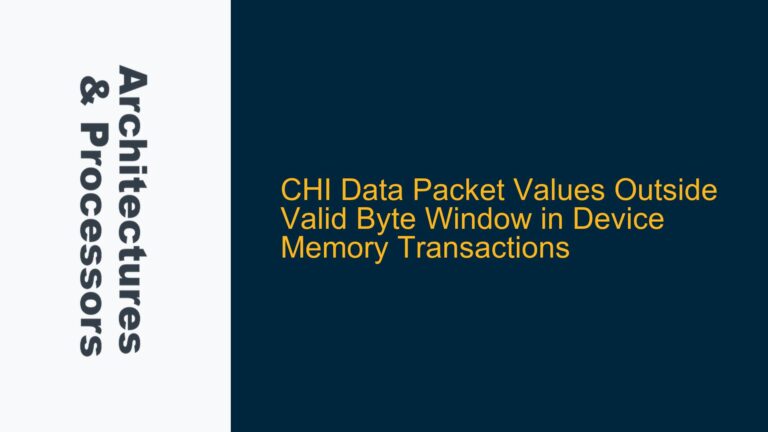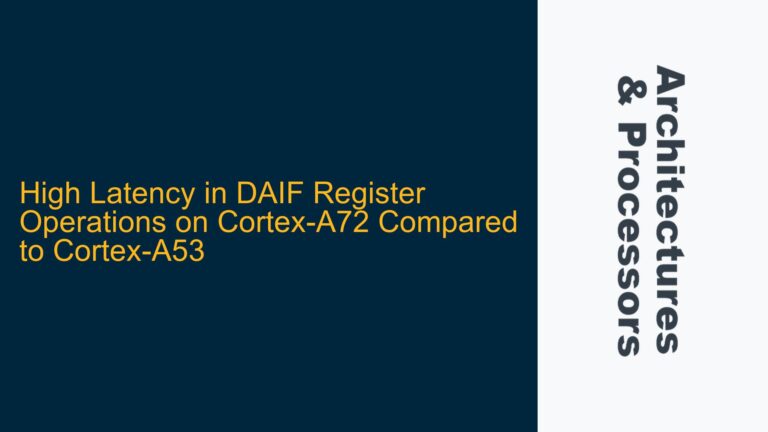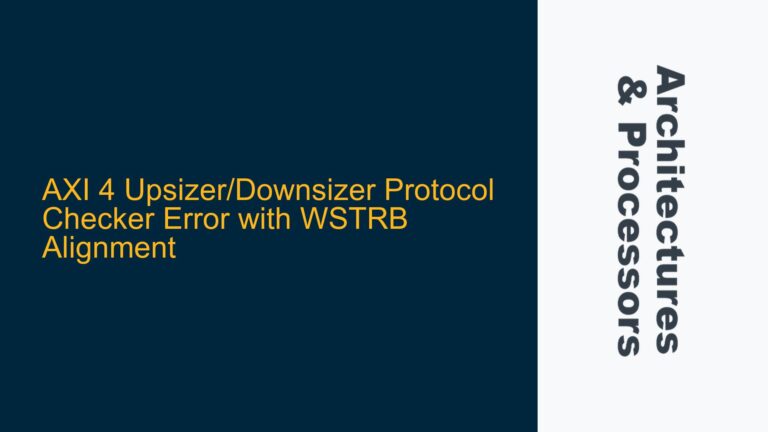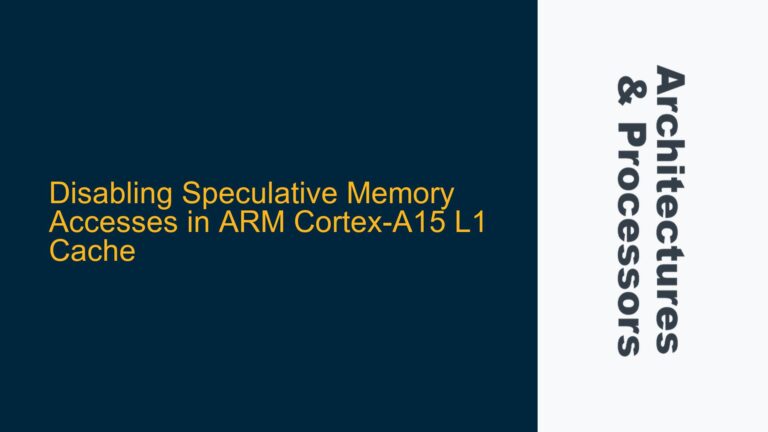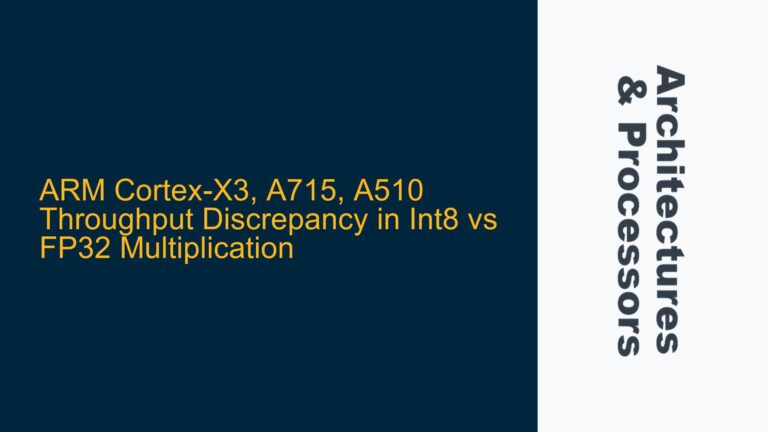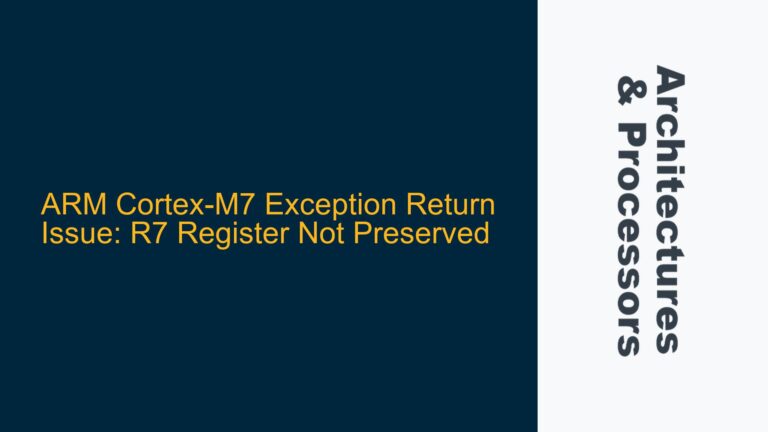Cortex-A76 L2 TLB Internal Memory Access via RAMINDEX
The Cortex-A76 processor, like many ARMv8-A architectures, provides mechanisms to access internal memory structures such as the Level 2 Translation Lookaside Buffer (L2 TLB) for debugging and performance analysis. The L2 TLB is a critical component in the memory management unit (MMU) that caches intermediate translations of virtual to physical addresses. Accessing this internal memory requires specific instructions and configurations, particularly when using the RAMINDEX mechanism described in the Cortex-A76 Technical Reference Manual (TRM), Section A6.6.
The RAMINDEX mechanism allows developers to index into the L2 TLB’s internal memory and retrieve data stored in registers such as ILData0, ILData1, ILData2, and ILData3. These registers contain information about the TLB entries, which can be invaluable for diagnosing translation faults, optimizing memory access patterns, or understanding the behavior of the MMU under specific workloads.
However, accessing the L2 TLB internal memory is not straightforward. It requires executing privileged instructions at Exception Level 3 (EL3), the highest privilege level in ARMv8-A, and involves careful handling of system registers and synchronization barriers. The process also raises questions about how to transfer data retrieved from these registers back to lower exception levels (e.g., EL1) for further processing or debugging.
RAMINDEX Encoding and Exception Level Constraints
The primary challenge in accessing the L2 TLB internal memory lies in understanding the encoding of the RAMINDEX value and the constraints imposed by ARM’s exception level model. The RAMINDEX value, such as 0x0000000001000D80 in the provided example, is not a memory address but rather an encoded value that specifies the index and other parameters for accessing the L2 TLB. This encoding is detailed in Tables A6-2 and A6-3 of the Cortex-A76 TRM.
The RAMINDEX value is composed of several fields, including:
- Index Field: Specifies the entry in the L2 TLB to access.
- Way Field: Indicates the way within the set-associative L2 TLB structure.
- Opcode Field: Defines the operation to perform, such as reading or invalidating a TLB entry.
For example, the value 0x0000000001000D80 might encode a specific index, way, and opcode combination for the Cortex-A57 processor. However, the equivalent value for the Cortex-A76 will differ due to architectural changes, such as differences in the L2 TLB size, associativity, or indexing scheme. Developers must carefully consult the Cortex-A76 TRM to derive the correct RAMINDEX value for their use case.
Another critical constraint is the requirement to execute the access at EL3. ARM’s exception level model restricts certain operations to higher privilege levels to prevent unauthorized access to sensitive system resources. In this case, accessing the L2 TLB internal memory is considered a privileged operation that can only be performed at EL3. This means developers must implement an exception level switch from EL1 (typically used for operating systems) to EL3 (used for secure monitor or firmware code) before attempting to access the L2 TLB.
Debugging Register Values Across Exception Levels
Once the L2 TLB internal memory has been accessed and the ILData registers (ILData0, ILData1, ILData2, and ILData3) have been populated, the next challenge is to transfer these values back to a lower exception level for debugging or further processing. This involves understanding how to move data between exception levels and how to integrate assembly code with higher-level languages like C.
The process typically involves the following steps:
- Switching from EL1 to EL3: This requires setting up the necessary exception vectors and using the
SMC(Secure Monitor Call) instruction to trigger a switch to EL3. - Accessing the L2 TLB: At EL3, the RAMINDEX mechanism is used to populate the ILData registers.
- Returning to EL1: After retrieving the data, the code must switch back to EL1 using an
ERET(Exception Return) instruction. - Transferring Data to C Code: The values in the ILData registers must be passed to C code for printing or further analysis.
Transferring data between exception levels can be achieved using general-purpose registers (e.g., X1 to X4) or by storing the values in memory accessible at both EL1 and EL3. However, care must be taken to ensure proper synchronization and avoid data corruption due to concurrent access or cache coherency issues.
For example, to print the values of the ILData registers in C code, the assembly function must save the register values to memory or pass them as arguments to a C function. This requires understanding the ARM Procedure Call Standard (AAPCS), which defines how function arguments and return values are passed between assembly and C code.
Implementing RAMINDEX Access and Debugging in Practice
To implement RAMINDEX access and debugging in practice, developers must follow a structured approach that combines assembly code for low-level operations and C code for higher-level processing. Below is a detailed breakdown of the steps involved:
Step 1: Switching from EL1 to EL3
Switching to EL3 requires setting up the secure monitor code and exception vectors. This typically involves:
- Configuring the
SCR_EL3(Secure Configuration Register) to enable EL3. - Setting up the
VBAR_EL3(Vector Base Address Register) to point to the exception vectors for EL3. - Using the
SMCinstruction to trigger a switch to EL3.
Example assembly code for switching to EL3:
// Assume EL1 code
SMC #0 // Trigger switch to EL3
Step 2: Accessing the L2 TLB at EL3
At EL3, the RAMINDEX mechanism is used to access the L2 TLB. This involves:
- Loading the RAMINDEX value into a register.
- Executing the
SYSinstruction to perform the access. - Using
MRSinstructions to read the ILData registers.
Example assembly code for accessing the L2 TLB:
// Assume EL3 code
LDR X0, =0x0000000001000D80 // Load RAMINDEX value
SYS #0, c15, c4, #0, X0 // Perform access
DSB SY // Data synchronization barrier
ISB // Instruction synchronization barrier
MRS X1, S3_0_c15_c0_0 // Read ILData0
MRS X2, S3_0_c15_c0_1 // Read ILData1
MRS X3, S3_0_c15_c0_2 // Read ILData2
MRS X4, S3_0_c15_c0_3 // Read ILData3
Step 3: Returning to EL1
After retrieving the data, the code must switch back to EL1 using the ERET instruction. This involves:
- Setting up the
SPSR_EL3(Saved Program Status Register) to specify the return state. - Loading the return address into
ELR_EL3(Exception Link Register).
Example assembly code for returning to EL1:
// Assume EL3 code
MOV X5, #0x3C5 // Set SPSR_EL3 for EL1 return
MSR SPSR_EL3, X5
ADR X6, return_address // Load return address
MSR ELR_EL3, X6
ERET // Return to EL1
return_address:
Step 4: Transferring Data to C Code
To transfer the ILData register values to C code, the assembly function must save the values to memory or pass them as arguments. This can be done using the AAPCS, which specifies that the first eight arguments are passed in registers X0 to X7.
Example assembly code for passing register values to C:
// Assume EL1 code
// Save ILData values to memory
STR X1, [SP, #-16]!
STR X2, [SP, #-16]!
STR X3, [SP, #-16]!
STR X4, [SP, #-16]!
// Call C function to print values
BL print_ildata_values
Example C code for printing the values:
void print_ildata_values(uint64_t ildata0, uint64_t ildata1, uint64_t ildata2, uint64_t ildata3) {
printf("ILData0: 0x%lx\n", ildata0);
printf("ILData1: 0x%lx\n", ildata1);
printf("ILData2: 0x%lx\n", ildata2);
printf("ILData3: 0x%lx\n", ildata3);
}
Step 5: Ensuring Synchronization and Cache Coherency
When transferring data between exception levels or between assembly and C code, it is crucial to ensure proper synchronization and cache coherency. This involves:
- Using
DSB(Data Synchronization Barrier) andISB(Instruction Synchronization Barrier) instructions to ensure that memory accesses are completed in the correct order. - Invalidating or cleaning cache lines if necessary to prevent stale data from being accessed.
Example code for ensuring synchronization:
DSB SY // Ensure all memory accesses are complete
ISB // Ensure instructions are executed in order
By following these steps, developers can successfully access the Cortex-A76 L2 TLB internal memory, retrieve the ILData register values, and transfer them to C code for debugging or further processing. This process requires a deep understanding of ARMv8-A architecture, exception levels, and the interaction between assembly and C code.

